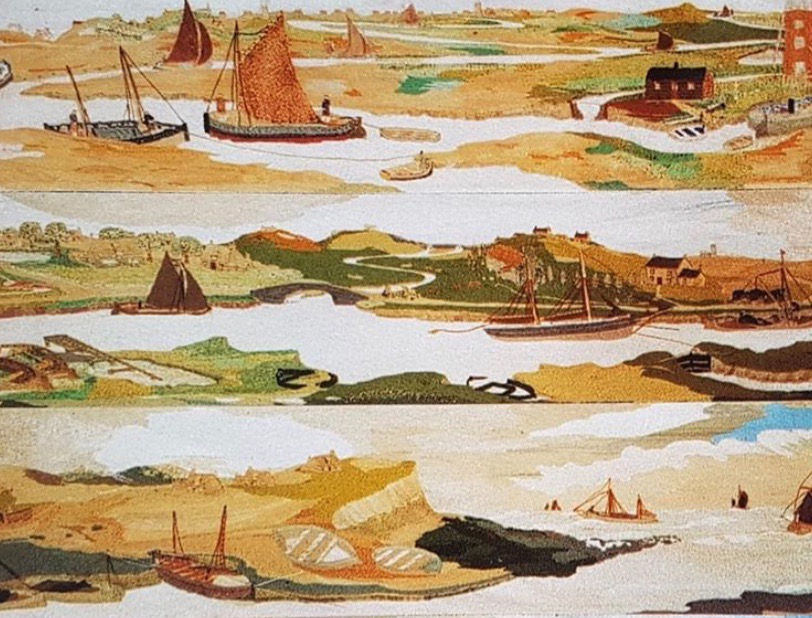John Craske: the Norfolk fisherman whose life was held together by threads
- Norfolk Notes
- May 24, 2020
- 4 min read
Updated: May 25, 2020

It was the sea at Blakeney which helped save the mind of an ailing Norfolk fisherman who became a world-acclaimed artist and embroiderer.
When John Craske became too ill to work, this self-taught artist would paint every surface in his house with images of the sea, sky and boats he loved. When he was too weak to stand and paint, he continued to produce his creations by embroidering those images while lying in his bed.
The work of this troubled man - who took to his bed for many months at a time - gained such fame it was exhibited in Boston and New York.
John Craske was born in Sheringham in 1881 and came from a long line of tough fisher folk who braved the wild North Sea to earn their living.
John too became a deep sea fisherman and while out on the water he would store the mental pictures which became the hallmark of so many of his paintings and embroideries. The sea was his passion and dominated his artistic work.
The Craske family then moved from Norfolk to fish from Grimsby but moved back to Norfolk in 1905 opening a fishmonger's shop in mid-Norfolk with fresh fish delivered daily from Lowestoft.
Three years later John married and ran a fish hawking business round the mid-Norfolk villages selling fresh fish from panniers lashed to his ponies.
But the First World War was the turning point which brought the frailty of John Craske’s health to light. Despite being called up and passed ‘fit to fight’, he returned home to his family in a state of collapse not even knowing his own name or age.
The initial diagnosis was that he was 'an imbecile'. He went to seven hospitals before finally being moved to a mental asylum near Norwich.
He was discharged into his wife’s care in October 1918, still prone to 'harmless mental stupors'. But it was his wife Laura who triggered his interest in painting and thread as a way of recovering from his illness.
She stretched a piece of calico, planned to cover a Christmas pudding, onto a frame so her unhappy husband could create a picture to keep him busy.
John sketched a boat and then Laura found some wool and showed him how to embroider it onto the calico. John found he could stitch while lying in bed.
His stupors continued for months at a time or, it is claimed, even for years. The cause has been debated. Some say diabetes but others say he suffered from an underlying deep depression. He was diagnosed with a brain abscess aged 36. He paid his doctor for his medical treatment with his paintings and embroideries.
Matters deteriorated in 1920 when John’s father died, and aged 39, he relapsed and needed to use a wheelchair.
His doctor told Laura ‘only the sea will save him’ and advised a move to the coast. John and Laura rented a cottage in Blakeney.
John cut some sails and in a borrowed boat the couple sailed each day in the estuary. Under the big Norfolk skies he built more material for his sketches.
When not well enough to sail, John would paint on any surface he could find in the cottage, on bait boxes, brown paper, cardboard, jugs and cups, mantlepieces and doors.
He continued to paint and embroider after they left Blakeney and moved to Hemsby near Great Yarmouth. It was there that he began making toy boats to sell to tourists. This is what attracted the attention of an influential passer-by and led to his discovery and national recognition.
The woman who bought his first painting for thirty shillings in 1927 exhibited it in a London gallery two years later. The gallery owner offered her a blank cheque to buy as many of John Craske’s artworks as possible and another London exhibition followed with further exhibitions of his paintings and embroideries in the United States.
John Craske died in 1943 in hospital in Norwich aged 62 still working on a panoramic embroidery. The cause of death has been given variously as diabetes, septicaemia or an infected lymph node in his neck.
In his lifetime Craske was briefly welcomed by the arts world. Within a few years of his death he was almost completely forgotten. Much of his work was destroyed, thrown away, burned, faded in sunlight on parlour walls, or left decaying in damp museum stores.
The unfinished work of epic proportions called The Evacuation of Dunkirk, is in the Norfolk Museums Collections. It is 10 feet long, inspired by radio reports of what Prime Minister Winston Churchill called the 900-boat ‘miracle of Dunkirk’. It is unfinished and fragile and currently not on display.
The work of John Craske can be seen in museums in Glandford, Sheringham, and his life is documented in the Britten-Pears Foundation Archive in Aldeburgh,
Suffolk. Several pieces of John Craske's work can be seen at Snape Maltings and The Red House, the home of the composer Benjamin Britten and of his partner, Peter Pears.
Books have been written about Craske’s remarkable life and the sickness which exposed his talent for recording his experiences as a fisherman on canvas, board, and with needle and thread.
Another epic work - ‘Panorama of the Norfolk Coast' - can be seen in the Glandford Shell Museum, two miles from Blakeney.
Glandford Shell Museum is open each year from Easter Saturday until the end of October - Tuesday to Saturday. Please note: All museums are closed so far in 2020 due to regulations during the coronavirus pandemic.





Comments